
The Swan River is a major river in the southwest of Western Australia. The river runs through the metropolitan area of Perth, Western Australia's capital and largest city.
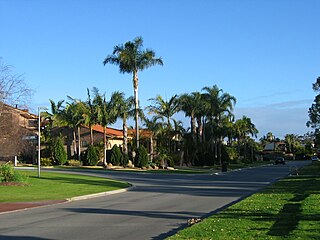
Carine is a suburb of Perth, the capital city of Western Australia, and is located 14 kilometres (9 mi) north of Perth's central business district (CBD) between Marmion Avenue and Mitchell Freeway. Its local government area is the City of Stirling.
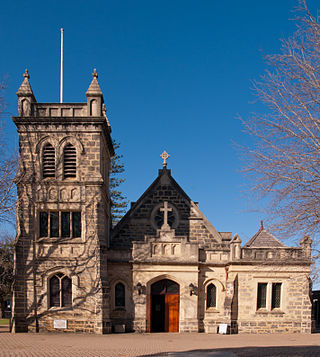
Claremont is a western suburb of Perth, Western Australia, on the north bank of the Swan River.
The Kwinana Freeway is a 72-kilometre (45 mi) freeway in and beyond the southern suburbs of Perth, Western Australia, linking central Perth with Mandurah to the south. It is the central section of State Route 2, which continues north as Mitchell Freeway to Clarkson, and south as Forrest Highway towards Bunbury. A 4-kilometre (2.5 mi) section between Canning and Leach highways is also part of National Route 1. Along its route are interchanges with several major roads, including Roe Highway and Mandjoogoordap Drive. The northern terminus of the Kwinana Freeway is at the Narrows Bridge, which crosses the Swan River, and the southern terminus is at Pinjarra Road, east of Mandurah.

Bicton is an affluent riverside suburb of Perth, Western Australia, located 10 kilometres (6.2 mi) south-west of the central business district. The suburb is mostly residential, and falls within the City of Melville local government area. Bicton borders the Swan River to the north, with the northern third of the suburb taken up by a Class-A reserve at Point Walter.
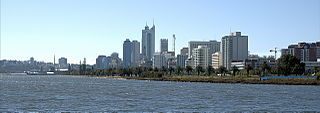
Perth Water is a section of the Swan River on the southern edge of the central business district of Perth, Western Australia. It is between the Causeway to the east, and Narrows Bridge to the west – a large wide but shallow section of river, and the northern edge of the suburb South Perth. It is considered a landmark of the City of Perth.

Burswood is an inner southeastern suburb of Perth, Western Australia, located immediately across the Swan River from Perth's central business district (CBD). Its local government area is the Town of Victoria Park. Burswood is the location of the State Tennis Centre, Perth Stadium, Belmont Park Racecourse, and the Crown Perth casino and hotel complex.

Applecross is an affluent riverside suburb of Perth, Western Australia, bounded by Canning Highway and the Swan River. It is located within the City of Melville.
South Fremantle is a suburb of Perth, Western Australia, located within the City of Fremantle.

Barrack Square is an open public square on the foreshore of Perth Water on the Swan River, located at the southern end of Barrack Street near the central business district of Perth, Western Australia.

Bayswater is a suburb 6 kilometres (4 mi) north-east of the central business district (CBD) of Perth, the capital of Western Australia. It is just north of the Swan River, within the City of Bayswater local government area. It is predominantly a low-density residential suburb consisting of single-family detached homes. However, there are several clusters of commercial buildings, most notably in the suburb's town centre, around the intersection of Whatley Crescent and King William Street and a light industrial area in the suburb's east.
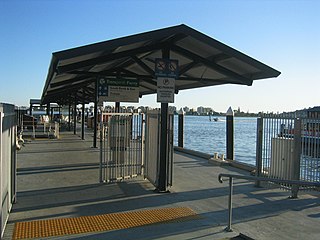
Barrack Street Jetty is located on the edge of Perth Water on the Swan River in Perth, Western Australia. It is no longer used on the Transperth ferry service between the Perth central business district and South Perth, having been replaced on that service with Elizabeth Quay Jetty.
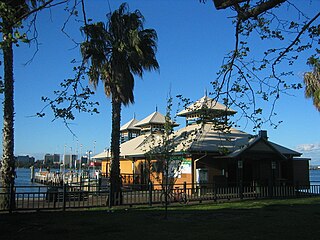
Mends Street Jetty is located in South Perth in Western Australia. The jetty is on the southern shore of the Swan River in the section known as Perth Water. The ferry service is primarily used for accessing the Perth Zoo from the Perth central business district.
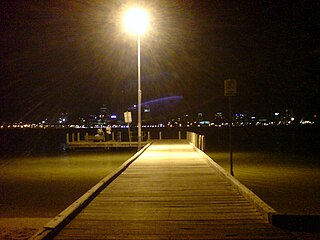
Coode Street Jetty is located in South Perth in Western Australia. The jetty is on the southern shore of the Swan River in the section known as Perth Water.
MV Perth is a wooden boat that has operated on the Swan River in Perth, Western Australia. Built in Fremantle in 1914, it is one of the oldest wooden boats still afloat in Western Australia.

Elizabeth Quay is a mixed-use development project in the Perth central business district. Encompassing an area located on the north shore of Perth Water near the landmark Swan Bells, the precinct was named in honour of Queen Elizabeth II during her Diamond Jubilee.
Sir James Mitchell Park is a park along the southern foreshore of Perth Water in Perth, Western Australia. It lies within the suburb of South Perth from Mends Street Jetty, to just south of Heirisson Island.

Captain Cook Cruises is a cruise and ferry operator on the Swan River, Perth.
The Elizabeth Quay Jetty is located at the western side of Elizabeth Quay inlet on the Swan River in Perth, Western Australia.
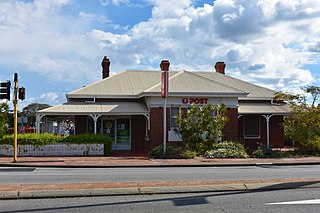
South Perth Post Office is a heritage-listed post office at 103 Mill Point Road, South Perth, Western Australia, Australia. It was added to the Australian Commonwealth Heritage List on 8 November 2011.



















